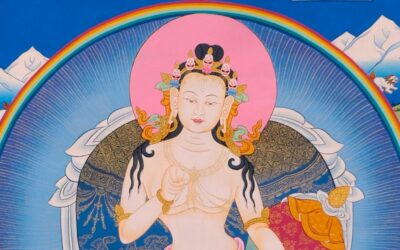
The Peacock feathers radiant display
Directly looking at the dynamics of emotions in the Dzogchen tradition
Last night, I had a dream… I dreamed that I was evolving in a world where emotions emerged like colors that were tinting the whole environment. Blue for anger, red for desire, green for jealousy, yellow for pride… The colors mixed with each other in as many shades as subtleties. In this infinite palette of possibilities, the mind, like a painter, drew its own reality. And in this painting of trees with turquoise foliage, ruby colored sky, emerald green birds and canary yellow clouds, I was witnessing an extraordinary and moving display… Everyday, if we had the possibility to see the environment tinted according to our emotions, we would be really surprised to perceive how much they impregnate the reality to make it what we believe to be our reality.

Written By Johanne Bernard
Blog | General Introduction to Dzogchen | The Dzogchen basics | The Dzogchen Journey
In the Peacock feathers radiant display, Johanne draws a beautiful parallel between our emotions and the radiant display of a peacock’s feathers. A must read!

“
Finally, when we learn to observe directly, the emotions allow us to perceive the extraordinary nature of our mind. It is because we have a body, thoughts, sensations, perceptions, and emotions that we have the possibility to access and recognize this nature…
We think we know emotions well: we have lived with them since we were young. They are like partners who accompany us throughout our lives. Some are our friends. We cherish them, and try to stay with them as much as possible because they are comfortable. Others are our enemies, and we avoid them at all costs, because they scare us or disturb us. Emotions are part of us. We have the impression that they constitute our identity: “This person is of a ‘jealous’ nature”, “such other one, since baby, was ‘angry'”… We attribute to them at the same time an external origin: this neighbor systematically makes us angry, this situation makes us afraid… A memory, sometimes, is enough to trigger them. And this endless ballet often exhausts us. How good it would be not to feel emotions sometimes!…
But, let’s come back to the dream of the beginning, what would become the extraordinary moving display that our mind offers, if the emotions were to disappear?
Dzogchen does not tell us to stop these emotions, it is impossible! Emotions are the expression of the dynamics of the mind. Like a peacock unfurling its feathers, the emotions are constantly flowing, revealing through the iridescence of their multitude of eyes, the incredibly agile quality of our own mind… If we feel affected by this deployment, it is because we are focusing our attention on the emotion itself, rather than on its dynamics. The Dzogchen tradition suggests that we let go of the concept of “emotion” and just watch its appearance, like a peacock watching the unfolding of its own feathers in a mirror. By remaining an observer of the incessant movement of our mind -unfolding, disappearing, unfolding- we gradually become accustomed to focusing our attention directly on the dynamic process of manifestation, rather than on its outcome.
By training ourselves in this way, we no longer recognize emotion as having an existence of its own, but as a dynamic. Recognized as an expression, a movement, the emotions spring up and disappear in an incessant but now natural game. Like bubbles on the surface of the water, they emerge and then return to their essence, which is the primordial basis of the mind, for the Dzogchen tradition. Anger, desire, pride, jealousy continue to emerge but, ungrasped, spontaneously free themselves and naturally return to their essence. Nothing needs to be removed or added. Nothing is to be done! The mind awakens to its own nature.
In the Dzogchen tradition, we speak of the ‘five basic passions‘ (desire-attachment, anger-aversion, confusion, pride, and jealousy) as the manifold expression of the nature of the mind. The peacock feathers symbolize the direct vision of these five passions as the five wisdoms, the manifestation of the luminosity of Rigpa.
Finally, when we learn to observe directly, the emotions allow us to perceive the extraordinary nature of our mind. It is because we have a body, thoughts, sensations, perceptions, and emotions that we have the possibility to access and recognize this nature… And this is also what “precious human existence “ means in Dzogchen!
So let’s rejoice, Emaho!!! as it is said in the tradition.
You can also listen the podcast on the emotions HERE.
More Posts
The Story of the First Masters: Garab Dorje
“The Story of the First Masters: Garab Dorje” is the first article in a new category about the masters of the Dzogchen lineage.
A Garland of Light
In “A Garland of Light”, Johanne talks about the way the lineage of the Great Perfection is passed on, since its beginning.
Stories When the Light Fades
In “Stories When the Light Fades”, Mila Khyentse recalls some of his Master’s Jack-o’-lantern stories told at night.
The ground (gzhi)
This article is the first in a new category designed to provide a better understanding of the essential words and concepts of Dzogchen.
The Call of the Lineage
In “The Call of the Lineage” Mila Khyentse talks about the Dzogchen lineage of his master Alags Chörten, called “the Diebu Lineage”.
The Supplication that Fulfills All Wishes
In “The Supplication that Fulfills All Wishes”, Mila Khyentse gives us a prayer from his Master for difficult times and conditions.






